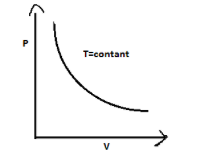Question
Question: In the equation \(P{V^\gamma } = {\text{constant}}\), the value of \(\gamma \) is unity. Then the pr...
In the equation PVγ=constant, the value of γ is unity. Then the process is
A) Isothermal
B) Adiabatic
C) Isobaric
D) Irreversible.
Solution
Heat absorbed or given out by the system even though at every stage the gas has the same temperature as that of the surrounding reservoir. This is possible because of the infinitesimal difference in temperature between the system and the surrounding.
Complete step by step answer:
Given that, PVγ=constant
The value ofγ is unity that is, γ=1
Then above equation becomes, PV=constant
The ideal gas equation for nmoles of gas is, PV=nRT
As the temperature remains constant, along with mass of gas in this process.
That is n, R, T are constants.
Then equation becomes,
PV=constant
∴P1V1=P2V2
This is the equation of the isothermal process.
A process in which a system undergoes physical changes in such a way that the temperature remains constant by the exchange of heat energy with the surrounding is known as isothermal process.
Additional information:
Consider a certain mass of a gas in a conducting cylinder fitted with a frictionless movable piston. The following conditions must be fulfilled to keep the temperature (for an isothermal process) constant.
-The cylinder and gas should be good conductors of heat.
-The cylinder should be in good thermal contact with surroundings.
-The surrounding should allow heat exchanges with the cylinder gas system keeping the temperature of gas essentially constant.
-The process should be quasi static.
-The process must be slow allowing sufficient time for the system to compensate for the changes, if any.
P−V graph of an isothermal process is a rectangular hyperbola. This graph is called isotherm.

therefore Correct option is (A).
Note: In an isothermal process the internal energy remains constant.
For an ideal gas internal energy depends only on temperature. Thus, there is no change in the internal energy of an ideal gas in an isothermal process.
